Key takeaways:
- Video call wellness emphasizes the importance of creating a comfortable environment, taking breaks, and establishing personal boundaries to enhance focus and emotional wellbeing.
- Maintaining connection and dedicating time for self-care during virtual interactions is vital for mental health, especially during challenging times like the Covid pandemic.
- Common challenges such as “Zoom fatigue” and distractions highlight the need for effective communication strategies, defined agendas, and engaging visuals to improve video call experiences.
- Personal routines, including meditation and preparation, can significantly enhance focus and engagement during video calls, fostering better communication and connection with participants.

Understanding video call wellness
Video call wellness is about recognizing how virtual interactions impact our mental and emotional states. I’ve often found myself feeling drained after back-to-back meetings. Reflecting on this, I realized the importance of taking breaks and creating boundaries, which helps me recharge and maintain focus throughout the day.
During my video calls, I’ve started incorporating practices that promote wellness, such as arranging my space thoughtfully and adjusting lighting to create a more inviting atmosphere. Have you ever considered how your environment influences your mood? I find that a comfortable setting not only helps me feel more relaxed but also makes me more engaged in the conversation.
Finally, the emotional aspect of video calls cannot be underestimated. Sometimes, I’ve experienced moments of genuine connection that lifted my spirits. Yet, I’ve also felt the weight of isolation creeping in when the screen became my only window to the outside world. How do you balance these emotional ups and downs? Understanding this duality has encouraged me to embrace small rituals that enhance my experience, whether it’s beginning a call with a friendly chat or simply taking a deep breath to ground myself.
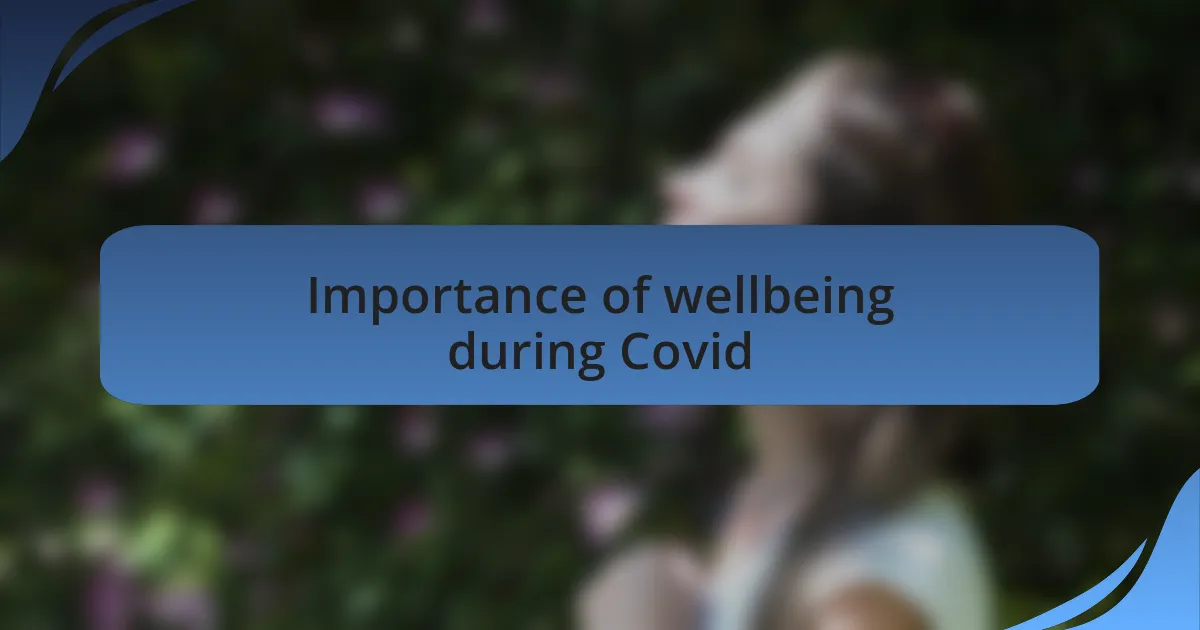
Importance of wellbeing during Covid
Wellbeing during Covid has become crucial as many of us shifted to virtual interactions. I remember the early days of lockdown when the uncertainty felt overwhelming. Each chat was tinged with a mix of relief at seeing familiar faces and anxiety about the world outside. This experience highlighted for me the necessity of maintaining emotional health amid such disruptions.
In my journey through these challenges, I’ve learned that dedicating time to self-care is essential. I often carve out moments in my day just for me, whether it’s a quick meditation or simply enjoying a cup of tea in silence. Have you ever noticed how these small breaks can transform your mindset? Taking care of our mental wellbeing helps us approach each meeting with a clearer mind and a lighter heart.
Moreover, the importance of connection can’t be overlooked. I’ve found that reaching out to friends for casual chats has boosted my spirits immensely. Do you ever feel the same way? It’s fascinating how sharing experiences, even over screens, can alleviate feelings of isolation and allow us to feel supported during unsettling times. Emphasizing wellbeing is not just beneficial for personal health; it creates a ripple effect that enhances the quality of our interactions with others.
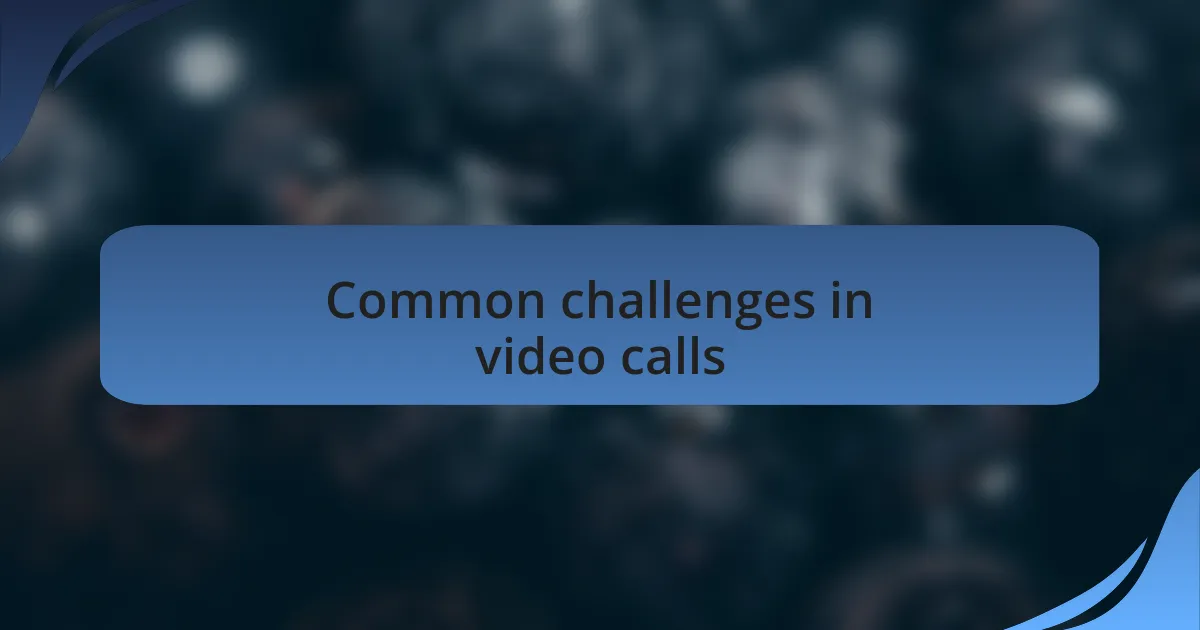
Common challenges in video calls
Video calls can often feel disjointed, making it tough to maintain a natural flow of conversation. I vividly recall a meeting where everyone spoke over each other, causing confusion and frustration. Have you ever been caught in that moment where you just wanted to finish a thought, but the technology interrupted? It really highlights how virtual connections can sometimes hinder genuine communication.
Another challenge is the phenomenon of “Zoom fatigue.” I noticed that after a full day of back-to-back calls, by the evening, my energy levels were completely drained. The constant screen time can be mentally taxing, and sometimes, I catch myself zoning out rather than fully engaging. Do you ever feel tired even before a call starts? It makes me think about how we might need to set personal boundaries, allowing for breaks to keep ourselves refreshed and present.
Then, there’s the issue of distractions in our home environments. I remember one call when my dog decided it was the perfect time to bark at the mailman, turning my attention away from the discussion. It’s a common scenario, and finding a distraction-free zone can become a real challenge, especially when family or pets are around. Have you experienced similar interruptions? It’s essential to acknowledge these small hurdles, as they can greatly impact our focus and effectiveness during video calls.
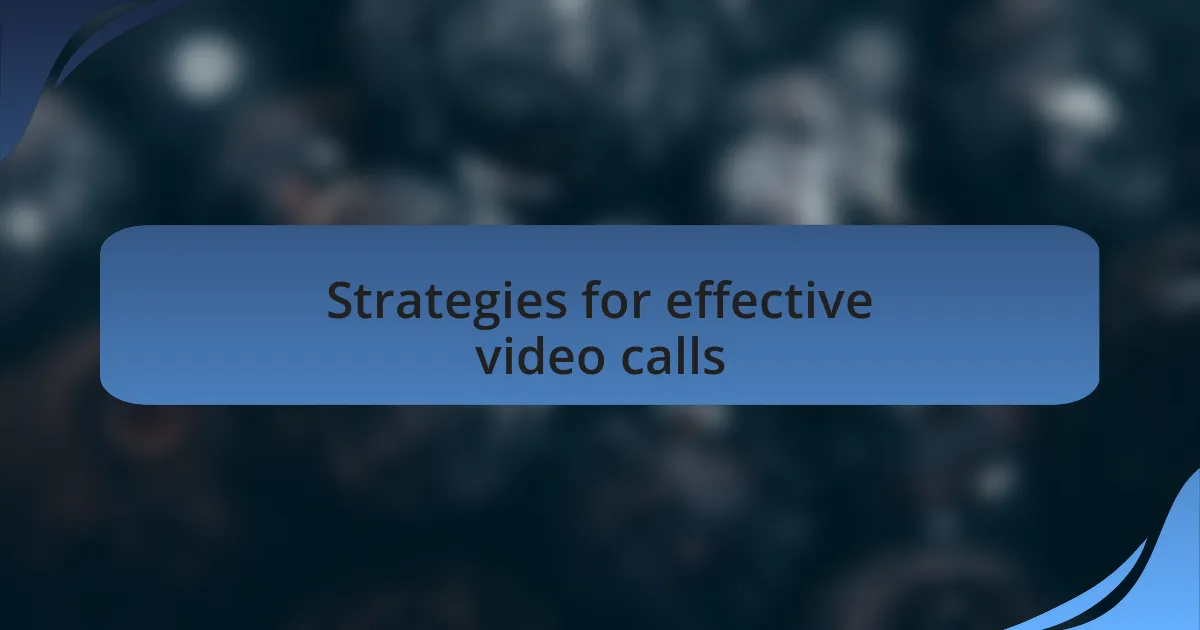
Strategies for effective video calls
Establishing a clear agenda before a call can significantly enhance its effectiveness. I often jot down key points I want to discuss, which not only keeps me focused but also helps guide the conversation. Have you ever walked into a meeting feeling scattered? Having defined objectives can turn that chaos into clarity, ensuring everyone remains on the same page.
One strategy I’ve found invaluable is to use visual cues, like nodding or hand gestures, to convey engagement. In one of my virtual workshops, I experimented with this, and it surprisingly sparked more interaction from others. Did you know that non-verbal communication can be just as influential online as it is in person? Emphasizing these cues can foster a sense of connection that may otherwise feel lacking in a virtual setting.
Additionally, I prioritize a workspace that’s visually appealing, minimizing distractions. I’ve noticed that when I arrange my background and lighting thoughtfully, it not only boosts my mood but also helps others remain focused. Have you ever felt more at ease just by looking at a well-organized space? It’s a small shift that can lead to more productive and enjoyable video calls.
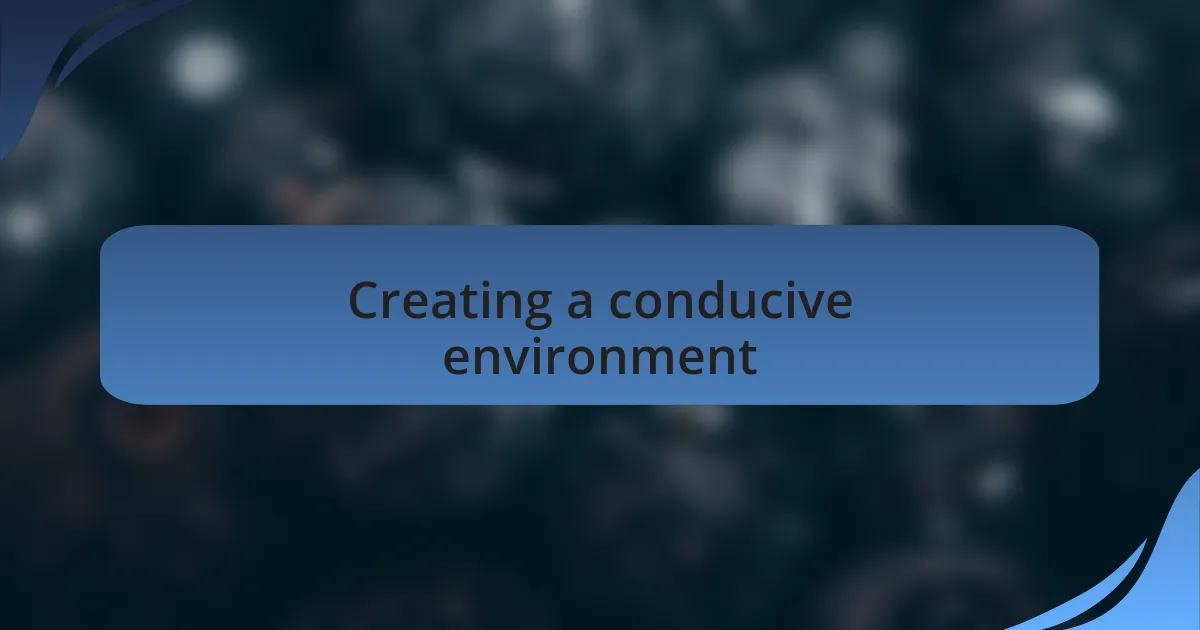
Creating a conducive environment
Creating a conducive environment starts with selecting the right location for your video calls. I’ve found that a quiet corner in my home, away from bustling family activities, creates a peaceful backdrop that allows me to concentrate. Have you noticed how distracting noises can pull your attention away? Finding a space that fosters tranquility can truly enhance your focus and effectiveness during calls.
Lighting is another crucial factor that I cannot emphasize enough. During one particularly important meeting, I realized that sitting near a window allowed natural light to brighten my face and mood. It felt like the sun was injecting energy into our discussion! If you’ve struggled with being seen or heard during calls, investing some time in good lighting can make a world of difference, making you look and feel more engaged and confident.
Moreover, I believe that personalizing your space can foster a sense of comfort and authenticity. I like to keep a few plants or inspiring quotes visible in my background; they not only bring a touch of personality but also spark positive conversation. Have you ever felt uplifted just by looking at something that inspires you? Creating an environment that reflects who you are can encourage openness and connection, making every interaction more meaningful.

Personal routines that improve focus
Establishing a personal routine before my video calls has been transformative for my focus. For instance, I set aside ten minutes to meditate or practice deep breathing, which helps me center my thoughts. Have you ever noticed how a few minutes of quiet can clear mental clutter? That intentional pause prepares me to be fully present, diminishing distractions.
I’ve also found that preparing a simple checklist of key points I want to discuss ensures I stay on track during the call. On one occasion, I overlooked a critical update because I hadn’t jotted it down beforehand, leaving me frustrated. How often do you wish you had said something important? These reminders keep me engaged and reduce the chances of my mind wandering mid-conversation.
Lastly, I like to choose a specific beverage to sip during my calls, whether it’s herbal tea or a refreshing glass of water. This habit has surprisingly become a ritual that helps me stay focused and grounded. Does anyone else find that a simple drink can refocus attention? The routine signals to my brain that it’s time to engage, making each call feel more purposeful.
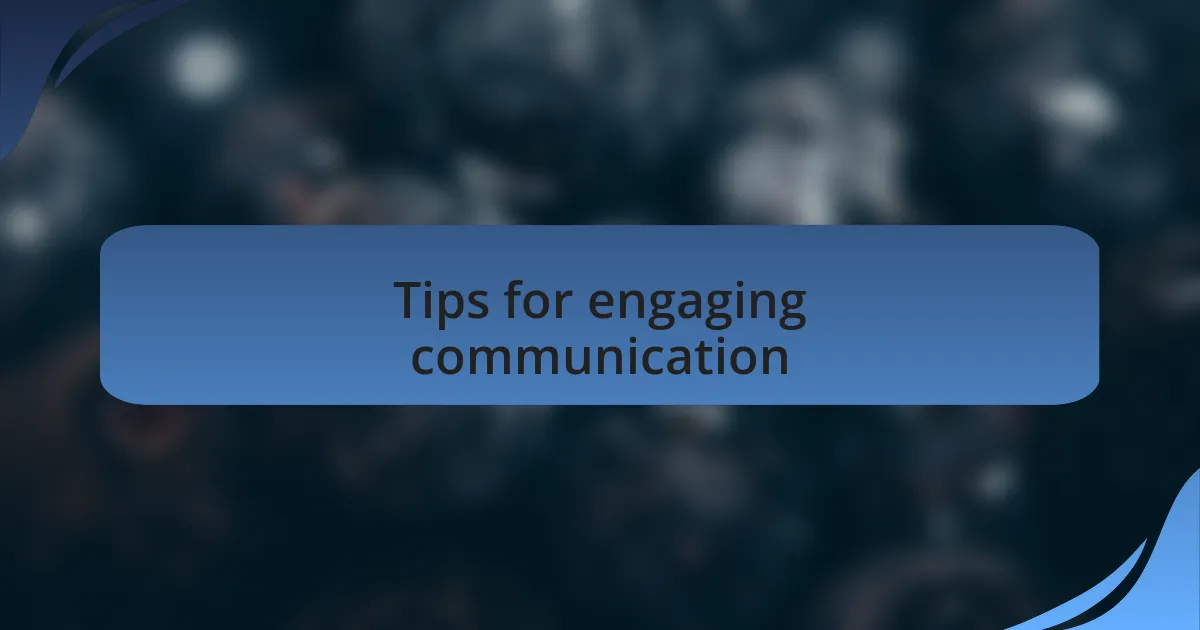
Tips for engaging communication
Maintaining eye contact is crucial for engaging communication during video calls. I remember a time when I was caught scrolling through my notes while someone was speaking, and it felt disheartening to see their energy shift. Have you ever felt that missed connection? Making an effort to look directly at the camera, rather than at the screen, can recreate the dynamic of in-person interactions and foster a more personal connection.
Another tip is to actively listen and respond to participants. I’ve found that nodding, using verbal affirmations, and asking follow-up questions can significantly enhance my engagement. For example, when a colleague shared a personal experience related to our discussion, I asked them to elaborate, and it turned the call into a collaborative dialogue. Isn’t it amazing how a simple question can deepen understanding?
Finally, utilizing visuals can be a game-changer. During one of my recent team meetings, I shared a relevant image that sparked a lively debate. As soon as I saw the engagement light up on everyone’s faces, I was reminded of the power of visuals. Have you ever noticed how much more lively a conversation becomes when there’s something to discuss beyond just words? Incorporating visuals can not only make the conversation more dynamic but also enhance retention of the topics discussed.